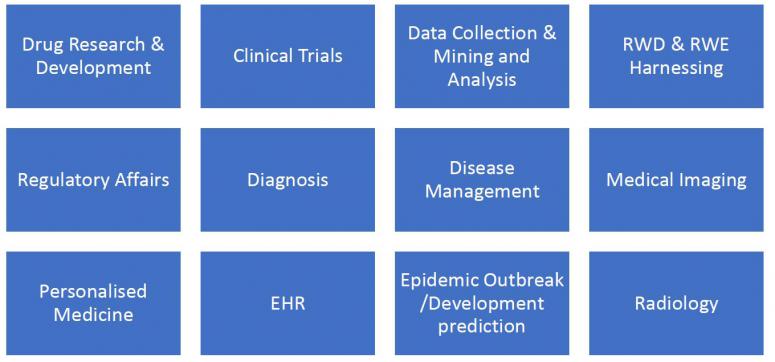AI - Artificial Intelligence
AI - Artificial Intelligence in healthcare
AI has already entered our daily live and improved many areas. In healthcare and pharmaceutical industry AI can also improve and leverage many areas from Development up to Treatment and Disease Management if adequate quality criteria are implemented.
Examples for applying AI in Healthcare:
RWD: Real-World Data; RWE: Real-World Evidence; EHR: Electronic Health Record
Research and Development of novel medications, Clinical Trial Design, Diagnosis, Personalized and Individualized Medicine, Smart Electronic Health Records (EHRs), Radiology, Imaging Procedures in Medicine, Data Acquisition, Data Mining, Data Analysis, Analyses of Real-World Data (RWD) and Real-World Evidence (RWE), Regulatory Affairs, Clinical Studies, Epidemic Outbreak Prediction.
Advantages of AI in Healthcare
The costs and need of resources for the development and progression of novel medications and healthcare tools are steadily increasing. Therefore, the pharmaceutical industry, the academia and regulatory authorities have to break new grounds to leverage the development and improve the treatment. With the help of AI, big advancements can be achieved if these novel methodologies are utilized in an adequate and appropriate manner. Big breakthroughs can be achieved not only in diagnoses but also in the field of personalized or individualized medicine, especially, when keeping in mind that the “one medicine fits all” approach does not apply any more for big advancements in achieving therapeutic success. Here the personalized and individualized medical approach is moving to the forefront. AI is totally suitable to leverage this area.
Some requirements for utilizing AI:
In order to profit from AI, certain quality criteria must be fulfilled and applied – the same principle that is valid in all areas. A huge advantage of AI (e.g. machine learning) is the speedy and structured processing of tremendous data packages. Nonetheless, this implies that the access of these data must be ensured and that these data fulfill a certain quality threshold in order to gain a huge benefit. Especially in the field of medical imaging, huge advances and success stories have been realized.
The AI process (e.g. ML = machine learning) in a nutshell
The process will be developed in several steps and the respective algorithm will be chosen. As a start a training set will be used to develop a draft of an algorithm. Then a tuning set will be used to improve the method. As a last step during the development process of an AI tool, a test dataset will be used and the validation procedure will be implemented. After internal validation and external validation, the AI can be used. One of the many pitfalls is the choice of a limited patient data set used as a training set. The limitation and too narrow selection can lead to overfitting. As a consequence, the generalizability might be jeopardized.
Caveat: Overfitting must be avoided in any case, so that the application could be applied to the broadest possible patient population with the respective disease. Overfitting could be a result of a small dataset or too a narrow selection of the patient population.
Example:
Objective of an AI algorithm: The algorithm should detect patients with hyperthyroidism.
The Trainingset contains data form e.g. asian patients only
Application of the AI: The final product is only applicable for asian patients and not
for patients with another ethnic background. The validity has not been tested and validated for other
ethnicities.
AI process (simplified):

